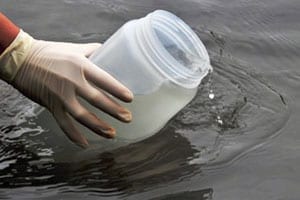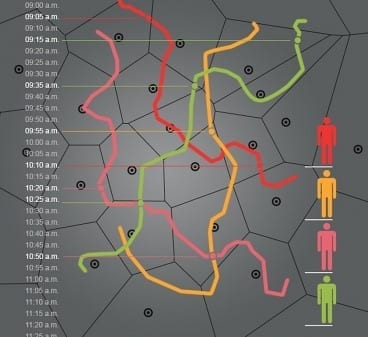
“Aquatic invasive species cause ecological and economic damage worldwide, including the loss of native biodiversity and damage to the world’s great fisheries”
A new research paper by a team of researchers from the University of Notre Dame’s Environmental Change Initiative(ND-ECI) demonstrates how two cutting-edge technologies can provide a sensitive and real-time solution to screening real-world water samples for invasive species before they get into our country or before they cause significant damage.
“Aquatic invasive species cause ecological and economic damage worldwide, including the loss of native biodiversity and damage to the world’s great fisheries,” said Scott Egan, a research assistant professor with Notre Dame’s Advanced Diagnostics and Therapeutics Initiative and a member of the research team. “This research combines two new, but proven, technologies — environmental DNA (eDNA) and light transmission spectroscopy (LTS), to address the growing problem of aquatic invasive species by increasing our ability to detect dangerous species in samples before they arrive or when they are still rare in their environment and have not yet caused significant damage.”
Egan points out that eDNA is a species surveillance tool that recognizes a unique advantage of aquatic sampling: Water often contains microscopic bits of tissue in suspension, including the scales of fish, the exoskeletons of insects and the sloughed cell and tissues of aquatic species. These tissue fragments can be filtered from water samples, and then a standard DNA extraction is performed on the filtered matter. The new sampling method for invasive species was pioneered by members of ND-ECI, including Notre Dame’s David Lodge and Chris Jerde, Central Michigan University’s Andrew Mahon and The Nature Conservancy’s Lindsay Chadderton.
Egan explains that LTS, which was developed by Notre Dame physicists Steven Ruggiero and Carol Tanner, can measure the size of small particles on a nanometer scale (1 nanometer equals 1 billionth of a meter). LTS was used in the research forDNA-based species detection where the LTS device detects small shifts in the size of nanoparticles with short single-stranded DNA fragments on their surface that will only bind to the DNA of a specific species.
“Thus, these nanoparticles grow in size in the presence of a target species, such as a dangerous invasive species, but don’t in the presence of other species,” Egan said. “In addition to the sensitivity of LTS, it is also advantageous because the device fits in a small suitcase and can operate off a car battery in the field, such as a point of entry at the border of the U.S.”
The Latest Bing News on:
World Wide Web
- An American journalist read her own obituary online, and soon discovered the strange world of obit pirateson April 26, 2024 at 12:10 pm
The low-budget videos are a new frontier of obit piracy. While spammy obit websites have been operating for years in the shadowy corners of the world wide web, recordings of death announcements are a ...
- Web O.No: Metaverse and Web 3.0 stunted by internet chaos, warn 87% of business leaderson April 26, 2024 at 1:01 am
A new study launched by Forrit, the next-generation, global content management system (CMS) provider, reveals that 89% of senior marketers and tech leaders are optimistic that Web 3.0 and the ...
- IndiGo Buys 30 Wide-Body A350 Planes, Aims To Double Capacity By 2030 | Detailson April 25, 2024 at 10:10 pm
IndiGo, which has a 60% share of the Indian aviation market, aims to double in size by 2030 with new domestic and international routes as well as destinations. With these new wide-body A350 planes, ...
- Tree farmer finds evidence of Wood Wide Web in Ohioon April 25, 2024 at 10:00 pm
An Ohio tree farmer believes he's documented evidence of the existence of the interconnection of forest plants via fungal networks on his property.
- IndiGo places firm order for 30 Airbus A350-900 aircraft, enters wide-body arenaon April 25, 2024 at 8:33 am
IndiGo orders 30 A350-900 aircraft for long haul routes starting deliveries in 2027. The fleet aims to connect Indian metros globally, expanding the n ...
- Veterans Affairs Tech Compliance Boss Chet Frith Talks ‘Leading The World’ In Accessibility In Interviewon April 24, 2024 at 2:34 pm
Chet Frith is director of the VA's 508 Compliance Office. Department of Veterans Affairs . Last August, I published an interview with Dewaine Beard. Beard works for the Department ...
- UnitedHealth says wide swath of patient files may have been taken in Change cyberattackon April 23, 2024 at 8:57 am
UnitedHealth says files with personal information that could cover a “substantial portion of people in America” may have been taken in the cyberattack on its Change Healthcare business.
- Mother trees and socialist forests: is the ‘wood-wide web’ a fantasy?on April 23, 2024 at 2:36 am
In the past 10 years the idea that trees communicate with and look after each other has gained widespread currency. But have these claims outstripped the evidence?
- Web Accessibility Basics: Why Your Website Needs to Be ADA Complianton April 22, 2024 at 10:40 am
Your guide to the best in personal financial products such as credit cards, mortgages, bank accounts, and brokerages.
- Learn about the world’s smallest park on the world’s smallest websiteon April 16, 2024 at 3:43 pm
The smallest park in the world now has a cleverly small website to celebrate it, and that site could get some big recognition. Portland’s Mill Ends Park is in a traffic median on Southwest Naito ...
The Latest Google Headlines on:
World Wide Web
[google_news title=”” keyword=”World Wide Web” num_posts=”10″ blurb_length=”0″ show_thumb=”left”] [/vc_column_text]The Latest Bing News on:
Fix the internet
- How short films helped launch the careers of these famous directorson April 27, 2024 at 7:00 pm
Everybody has to start somewhere, even huge directors like Christopher Nolan and Denis Villeneuve have short films that helped launch their careers.
- The 10 worst changes to stock Androidon April 27, 2024 at 8:00 am
From fooling around with the power button to the Internet tile, not all of Google's changes to Android were great.
- Taylor Swift Exposes the Dark Side of Music Criticismon April 27, 2024 at 5:00 am
Connecting decision makers to a dynamic network of information, people and ideas, Bloomberg quickly and accurately delivers business and financial information, news and insight around the world ...
- How to fix the ‘Not Registered on Network’ error on a Samsung Galaxy phoneon April 27, 2024 at 3:01 am
Have a Samsung phone? Seeing an annoying Not Registered on Network error and unsure what to do about it? Here's everything you need to know to fix it.
- Two arrested for theft of AT&T cable that took down internet hereon April 27, 2024 at 1:33 am
Adams County Sheriff’s Deputies responded to a call at approximately 11 a.m. Friday concerning the theft of AT&T internet cables from a location on Powell Road. The cable had been cut and stolen.
- How to Fix the "No Internet Secured" Error on Windowson April 26, 2024 at 8:00 am
The message "No Internet, Secured" usually appears when your connection is weak. You can reboot your router to refresh your network, which might also improve its speed. Alternatively, you can also ...
- How to Fix Search Results in the Windows 11 Start Menuon April 24, 2024 at 3:01 pm
Windows 11's start menu, by default, searches the internet and your computer at once. Here's how to keep things local.
- Algorithmic Curation Is Ruining The Internet. Here's How to Fix Thaton April 24, 2024 at 6:00 am
Machine learning researchers at Stanford have developed an innovative way to moderate online content—one that could potentially make the web less polarizing and divisive.
- Internet For Gaming: The Best NBN Plans To Help Fix Your Pingon April 23, 2024 at 9:57 pm
If your lagging is getting out of hand, you might be looking into finding the right internet for gaming. Here are our top tips and ISPs.
- Forward Thinking: Can feminism fix the internet?on April 23, 2024 at 5:37 pm
Dr Kerry McInerney is a research fellow at the Leverhulme Centre for the Future of Intelligence, University of Cambridge, and the AI Now Institute. This is the last of four programmes from the Oxford ...
The Latest Google Headlines on:
Fix the internet
[google_news title=”” keyword=”fix the internet” num_posts=”10″ blurb_length=”0″ show_thumb=”left”]










